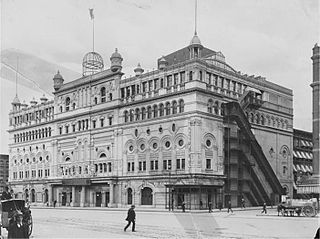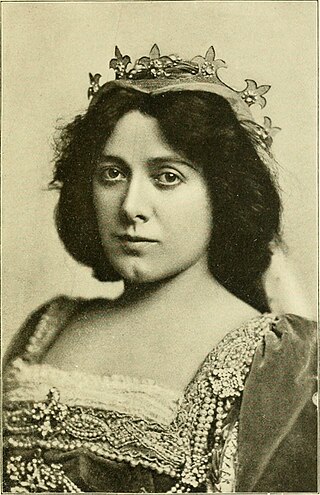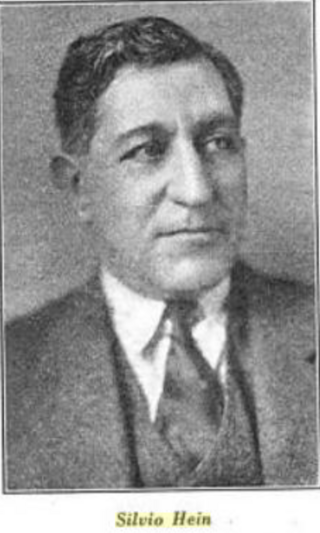
The Olympia Theatre, also known as Hammerstein's Olympia and later the Lyric Theatre and the New York Theatre, was a theatre complex built by impresario Oscar Hammerstein I in Longacre Square, New York City, opening in 1895.

Alfred Hickman was an English actor. He was married to actress Nance O'Neil. He appeared in 35 films between 1914 and 1931.
Louis De Lange, also known as Louis De Lange Moss was an American playwright, actor, and theatrical manager. As a stage actor he primarily appeared in light operas and musicals; notably portraying Sir Joseph Porter in the original production of John Philip Sousa's pirated version of Gilbert and Sullivan's H.M.S. Pinafore in Philadelphia, on Broadway and on tour in 1879. As a dramatist he mainly wrote the books for musicals; often in collaboration with writer Edgar Smith on projects created for the comedy duo Lew Fields and Joe Weber. De Lange also worked as Fields and Weber's manager for their national tours. His wife was the Broadway actress Selma Mantell who appeared in the Ziegfeld Follies among other Broadway shows. Their son was the bandleader and lyricist Eddie DeLange.

Louis Harrison was an actor, playwright, comedian, lyricist, librettist, and theatre director. As both a performer and playwright, he was mainly active within the genres of musical theatre and light opera.
Ernest Albert, born Ernest Albert Brown, was an American painter, illustrator, muralist, and scenic designer. He was a prolific scenic designer, first in St. Louis and Chicago and then on Broadway. He is considered a major American landscape painter and was elected the first president of the Allied Artists of America in 1919.

When Knighthood Was in Flower is a play in four acts by Paul Kester. It is based on the 1898 novel of the same name by Charles Major. The work premiered on Broadway at the Criterion Theatre on January 14, 1901. It ran for a total of 176 performances; closing in June 1901. The original production was produced by Charles Frohman and used sets by Ernest Albert, Frank E. Gates and Edward A. Morange. The costumes were designed by Mrs. Charles Hone and Harper Pennington. The cast was led by Bruce McRae as Charles Brandon and Julia Marlowe as Mary Tudor among others.
The Billionaire is a musical in three acts with music by Gustave Kerker, and both book and lyrics by Harry B. Smith. The show was written with the backing of producers Klaw and Erlanger and was made specifically for the talents of Jerome Sykes who portrayed "The Billionaire", John Doe. The action of the musical begins in Nice, France during Carnival where the billionaire Sykes meets a young American girl, Pansy Good, studying to be an actress. Impressed with her talents, he buys her Doe's Theatre in New York City and establishes her as a star. Later, Doe attempts to ride a horse in a race at the Longchamp Racecourse in Paris, but is too fat to succeed. Pansy rides the horse instead and wins the race.
Coming Thro' The Rye is a "satiretta" or musical in two acts with both lyrics and book by George V. Hobart and music by A. Baldwin Sloane and J. Sebastian Hiller.
Gates and Morange was a New York City based firm of designers and builders established in 1894 by brothers Frank E. Gates and Richard H. Gates, and the artist Edward A. Morange. The firm had a prolific career as scenic designers for Broadway from the 1890s through the 1930s; creating sets for more than 50 productions. The firm also created designs for trade shows, exhibitions, and businesses. While the organization's work as set designers ended after the mid-1930s, the firm continued to operate in other capacities until it closed in 1953.
The White Hen is a musical in two acts with music by composer Gustav Kerker, a book by Roderic C. Penfield, and lyrics co-authored by Penfield and Paul West. Set in Tyrol, Austria, the story takes place at an inn, 'The White Hen', owned by Hensie Blinder. The musical begins after Blinder returns from a trip to Vienna in which he engaged a matrimonial agency to help him find a wife. Upon his return to the inn, several women arrive in response to the advertisement placed by the agency and a comedy of errors ensues; including Blinder mistakenly believing he has committed the crime of bigamy.
Paul West was an American playwright, lyricist, newspaper editor, journalist, screenwriter, author, and talent agent. After working as a journalist in Massachusetts from 1888 to 1892, he began his career in the theatre as a press representative for Charles H. Hoyt; followed by a season as the business manager for the opera singer and actress Camille D'Arville and the comedian Frank Daniels. From 1898 to 1911 he worked on the editorial staff The New York Sunday World during which time be began a career as a prolific lyricist for both Broadway musicals and Tin Pan Alley publishers of popular song; publishing more the 500 songs during his lifetime. He also worked as a playwright, penning both plays and the books for several musicals. More than 15 of his stage works were mounted on Broadway between the years 1902–1913. In 1904 his children's book The Pearl and the Pumpkin was published; a work which he later adapted into a 1905 musical.
Otis C. Sheridan was an American character actor who had a five decade long career on the stage from the 1890s into the early 1940s. He made his Broadway debut in 1901 as Ludwig Dollar in Thomas Q. Seabrooke's revival of the musical The Rounders. He appeared in several more Broadway musicals and plays into the late 1930s, and was also active in regional theatre until his retirement from the stage in 1941. In addition to a career in the theater, he appeared in the films The Night Angel (1931) and Sweet Surrender (1935).

Otho Herbert Dilley, better known by his stage and pen name Herbert Dillea, was an American composer, songwriter, and conductor. He composed the music to three Broadway musicals: The Floor Walkers (1900), The Head Waiters (1902), and My Wife Won't Let Me (1906). As a songwriter, Dilley was best known as the composer to the popular standard "Absence makes the heart grow fonder" ; a work which was recorded multiple times by singer Harry Macdonough and cornetist Jules Levy for records made for the Victor Talking Machine Company and Columbia Records from 1902 through 1905, and later was recorded by Wayne King in 1947. He was also the composer of the ragtime piece Rag time society which was recorded several times by the Metropolitan Orchestra for Victor in 1901 and 1902.
Fritz in Tammany Hall is a musical in three acts with music by Jean Schwartz, lyrics by William Jerome, and a book by John J. McNally. The musical takes place in 1905 in New York City and on Long Island. It was a political spoof of New York City politics of that period.
In Hayti is a musical in three acts with music by Jean Schwartz, lyrics by William Jerome, and a book by John J. McNally. It premiered at Broadway's Circle Theatre on August 30, 1909. It closed after 56 performances on October 16, 1909. Produced by Klaw and Erlanger, the show was directed by A. H. Holbrook and choreographed by Julian Alfred. The work was created as a starring vehicle for vaudeville and minstrel show stars James McIntyre and Thomas Heath who were known for their work as blackface performers. It was the second musical created by the songwriting team of Schwartz and Jerome for McIntyre and Heatth; the first being the tremendously popular 1905 musical The Ham Tree.The plot of the show revolves around Colonel Scott's attempt to control the chicken market in Haiti in the midst of a revolution.

The Sleeping Beauty and the Beast is a musical in three acts with music by J. M. Glover and Frederick Solomon and lyrics by J. Cheever Goodwin. Its book by John J. McNally and Goodwin was adapted from the Theatre Royal, Drury Lane's 1900 pantomime of the same name by J. Hickory Wood and Arthur Collins. The musical also included additional music and lyrics by the songwriting team of Jean Schwartz and William Jerome, and by the African-American creative team of Bob Cole, James Weldon Johnson, and J. Rosamond Johnson.
The Wild Rose is a musical in two acts with music by Ludwig Engländer and both book and lyrics by Harry B. Smith and George V. Hobart. The work also contained the hit song "A Most Unlucky Man" by the songwriting team of Jean Schwartz and William Jerome.
A Million Dollars is a musical in three acts with music by A. Baldwin Sloane, lyrics by George V. Hobart, and a book co-authored by Hobart and Louis Harrison. The musical's plot is about a barber who comes into sudden wealth and rapidly spends his new fortune. The work premiered on Broadway at the New York Theatre on September 27, 1900. It ran there for 28 performances; closing on October 20, 1900.

Silvio Hein was an American composer, songwriter, conductor, and theatrical producer. He was a songwriter for Tin Pan Alley and composed the scores to fourteen Broadway musicals. His most successful stage work was the 1917 musical Flo-Flo which he created with the French librettist and playwright Fred de Gresac. His songs were also interpolated into musicals created by others, including The Little Duchess and Ziegfeld Follies. In addition to his work writing music, he also worked as both a conductor and producer on Broadway. In 1914 he was a founding member of the American Society of Composers, Authors and Publishers.
When Dreams Comes True is a musical in three acts and four scenes with music by Silvio Hein and both book and lyrics by Philip Bartholomae.







